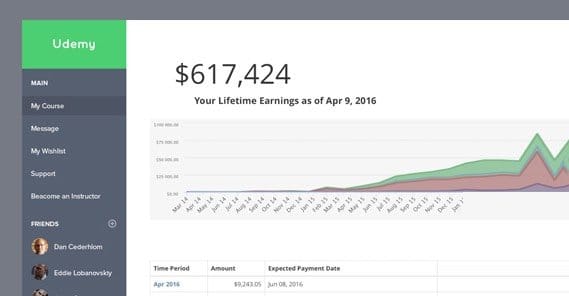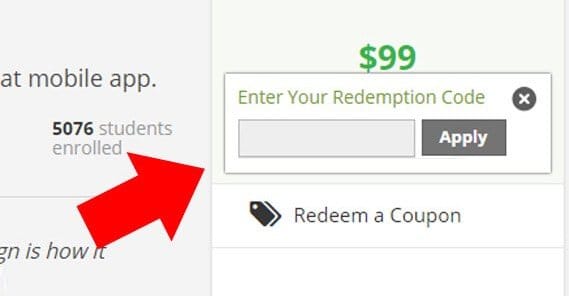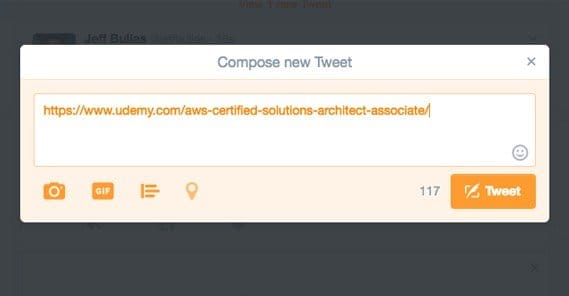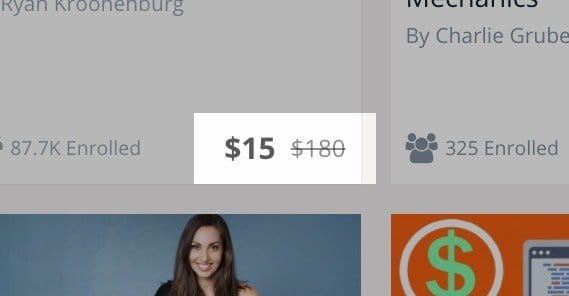20 Ways to Get More Sales on Your Udemy Course

Udemy is an online academy and a great source of relatively cheap learning. There are a ton of great courses out there, though there are also tons of bad ones thrown up by people looking to make a quick buck. In fact, there are even Udemy courses on how to make money with Udemy courses.
I’m going to save you a trip to Udemy and a purchase of one of those courses, though, and give you tips to maximize your Udemy traffic and sales right up front. If you have a course you want to promote, or if you want to make money and don’t know where to start, here are ways you can make Udemy make you money.
1. Seed Positive Reviews
Courses with more reviews rank higher in the Udemy search results. Users also look at reviews to see if a course looks like something they want to purchase or not. A course with few or no reviews will attract little or no traffic, and the traffic it does get will have a low conversion rate.
Seed some reviews for yourself, but don’t use bots or purchase fake reviews. Instead, get friends and family to leave positive reviews. Some of them may even like your course enough to actually pay for it, though you should always offer a steep discount or reimbursement for what they pay.
2. Offer Coupon Codes for Friends and Followers
You can create a variety of coupon codes for your Udemy course, ranging from minor discounts to completely free. I recommend making several tiers. Make some freebies for distribution to your friends, family, and inner circle of close relationships.
Make some steep discounts for blog readers, paid subscribers, and people buying related content like ebooks. Make some more minor discounts for general distribution on social media or through influencer marketing. The idea is that the more engaged a person is with your brand, the better the discount they’ll be getting.
3. Promote Coupons on Deal Sites
Some of your lower or mid-range value coupons can be used to promote your course on various deals and coupons sites around the web. Make sure your course is something their user base might be interested in, of course. You don’t want to go to BestPerfumeCoupons.biz to advertise your course on amateur paleontology, after all. However, some of the more broad or generalized deals sites might welcome your post. Sites like Slickdeals or CrunchADeal might be a good fit.
4. Market via Blog
Obviously, one of the best ways to market a course is through your own blog. That’s where you have traffic and readers, and that’s where you can advertise for free without stepping on anyone’s toes. You have all the power of your site SEO pulling for you. You can market via your blog in a bunch of different ways, too. A blog post covering the topic in broad strokes can link to an in-depth course. Sidebar ads and banner ads can go a long way when they’re native. Plus you can use your own Google tracking parameters in your blog links.
5. Market on Social Media
Second to your blog is your social media presence. There is often more immediate engagement via social media, but you also tend to lose visibility very quickly.
You do get quite a bit of immediate feedback on how people feel about your offer and the deal you’re giving them. You can use this feedback to adjust your coupons later, offering a better deal if you failed to attract people with the previous attempt. Keep an eye out to make sure you’re not losing followers when posting the deals, as well. If you’re feeling punchy, you can also use an offer claim app like Gleam to give out a limited number of your coupons to your audience, to make them seem more exclusive.
6. Market in Udemy Groups
Throughout the internet, you can find communities dedicated to Udemy. For the most part, these will take the form of Facebook Groups, LinkedIn Groups, Google+ Communities, and web forums. Locate these and monitor them for a while to see if they’re reasonably active. Then register and join in. Participate for a while, to make yourself more than just someone dropping in for self-promotion, and do what you can to assist other members. Then, once you’ve established yourself as a valuable member of the community, you can start posting your own links. Use mid-to-high value coupons here, because these are more exclusive groups and you want to reward these people so they help you in other ways as well.
7. Market in Topic Groups
By “topic groups” here I mean all of the same sort of online communities as in the previous step, except I mean groups dedicated to the topic of your course. For example, if your course is about using a metal detector in unusual spots, you can join groups about metal detecting and prospecting. Go through the same process with becoming a valued member of the community before you advertise, so people know that you’re not just trying to exploit them, even if you totally are. Again, use enticing coupons to try to build your audience quickly. Essentially, all of this, but for Udemy instead of affiliate links.
8. Include an Email Opt-In for Future Traffic
In all of your courses, preferably near the front and near the end, you should include a call to action to get people to visit a link to a landing page, where they can sign up for your email mailing list.
This list should be kept separate from your other marketing lists, and used specifically as a students list. Ideally, you can give out a coupon for other courses, some free supplementary material, or a free or cheap ebook for further enticement to sign up. This shows you the people who take your courses and who are interested in learning more. This list is excellent for a number of reasons, but the most obvious is, of course:
9. Market Through Email Lists
This. Whenever you publish a new course, you can send a mail out to the students who opted in to your mailing list from your past courses. You can also send out a message to your other mailing lists, like your general blog subscribers list. The reason you want to keep them separated is because you can give out better coupons to students than you give to normal blog subscribers. You can also try to convert blog subscribers to your students list under the offer of future, better coupons. Just make sure to be clear that the lists are separate, and keep track of overlap. I like to have three lists; one for blog subscribers who aren’t students, which gets all of my messages. One for blog subscribers and students, who get Udemy messages from the students list and blog messages – but not Udemy messages – from the blog list. Then one for just students, who get Udemy messages and the occasional “hey check out my blog” list.
10. Keep Courses Short to Boost Completion Rates
Completion rates are notoriously poor for most Udemy courses, and one of the reasons for that is inflation. A lot of course teachers make lengthy video courses and boast “you get 30+ videos for $10!” The problem is that those 30 videos only contain 2-3 blog posts worth of content, stretched out and overexplained. People get tired of it and abandon the course. You get better completion rates by keeping honest with your value and making your courses dense with valuable information.
11. Participate in Udemy Site Sales
Udemy often has site-wide sales. They also tend to give search preference to courses that participate in these sales. You can put your courses on sale yourself, but you’ll still turn up underneath the courses on site sales, because Udemy wants to promote the value of their own sales. Therefore, you want to participate in the Udemy site sales whenever possible.
Just make sure you’re using courses you can afford to “give away” for what might be lower than they’re usually worth. Use it for introductory courses, not your high value courses.
12. Do Limited Exclusive Free Course Giveaways
A lot of popular blog posts about Udemy success recommend giving away your courses by the hundreds. The idea, they claim, is to rack up a large number of students enrolled in the courses, a large number of reviews, and a large number of completions. I don’t think this is truly a good method, though. You can seed some interest with free giveaways, but I highly recommend you keep them limited. The more you give away, the less people will want to pay for them, because they’ll have seen the courses go for free frequently. Plus, after a certain point, every free student is a paying student whose money you’re losing.
13. Create Course Preview Media for Blogs, YouTube
It’s generally a good idea to tease what’s in a course, so people know what they’re getting. Most people won’t want to buy a course, particularly an expensive course, sight unseen. If you tease the value, though, you can hook them and get them interested so they are more likely to buy. Here are some ideas for supplemental or teaser content:
- A YouTube video acting essentially as a commercial for the course.
- A blog post that covers the topic in light detail, with promises of more in the actual course.
- A SlideShare deck that covers an outline of what’s in the actual course.
14. Cite Influencers in the Course and Notify Them
One common method of getting more exposure online these days is influencer marketing. Write a great blog post, cite a popular post on another blog, and inform the writer of that post that you linked to them. A good portion of the time, the influencer you linked to will be happy to link back to you, or at least share your post on social media.
You can get the same effect with a Udemy course by citing a post as a source or linking to one of their posts as supplementary content, then telling that influencer that you did so. There’s a good chance they’ll link to you or share your course. It’s not guaranteed, but every hit is better than nothing.
15. Pay for Advertising for Proven Popular Courses
Paid advertising can bring in a lot of traffic, and it’s generally quite cheap, particularly if you’re working with niche courses that have narrow audiences but not deep competition. The trick is, you want to make sure your courses are proven to convert before you spend a bunch of money on the advertising. If you pay to advertising everything, you start to lose money on the courses that don’t convert. You can always try to pay for an initial boost, but keep an eye on it and cut off the ads if they aren’t performing quickly.
16. Write Case Study Blog Posts on Course Performance
You don’t need to limit yourself to just sending people to your courses from your blog; you can write Udemy case studies and get traffic from other blogs as well! Plenty of people looking to make money with Udemy want to know how successful they can be, and how you achieved the success you did. Create case studies, create a course about them, and keep the traffic cycle moving.
17. Keep SEO in Mind for Course Titles and Descriptions
I shouldn’t really have to add this, but Udemy and Google’s indexation of Udemy both rely on the titles and course descriptions, since the actual content of the course is hidden from non-paying eyes.
You need to maximize the focused, long-tail SEO of both, in order to get the maximum amount of visibility possible.
18. Ask Users What They Want and Provide New Courses
Sometimes the simplest way to get more students to your courses is to ask your existing students what they want to see. I like two ways of doing this. The first is to send a message out to your student mailing list with a link to a free-form survey. You can analyze the results and figure out what should come next. The other is to add a link to a similar survey to the end of your courses.
19. Aim for Volume in Courses and Brand Loyalty
Udemy courses go on sale so often, and there’s so much competition, that it’s hard to make one over-the-top course with a high price tag succeed. In fact, the constant sales have driven away more than one freelancer. As a result, I like to push a lot of shorter, low-cost courses rather than one big one. People will start to recognize your content and will form some brand loyalty, buying multiple courses at a time, to make up for the low price tag.
20. Include Supplemental Monetization Strategies
Since the average price of a Udemy course that succeeds in bulk is around $10, you’re not getting paid much for each of them. I like to include other means of making money along the way. Affiliate links to supplementary products, links to ebooks that discuss further topics, and links to pages on your blog with banner ads all work out fairly well. You get to double-dip on the value.
 ContentPowered.com
ContentPowered.com












Great tips!